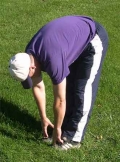By Derek Rosenfeld
There are several reasons why softball is usually the sport of choice when organizations, be them corporate or blue-collar, decide to form an athletic team. Despite basketball’s more global appeal or the high ratings and near national holiday-like atmosphere generated by football’s Super Bowl, baseball continues to be America’s pastime. As cliché as the game’s qualities have become to many, its pastoral nature, familial bonding aspects, and near unending statistical construct never fail to provoke an image of a simpler, more innocent time. Softball, a more accessible variation of the game, provides the perfect middle ground for aspiring athletes with a wide range of athletic skills–from those with little to no athleticism at all to others who can play at near-professional levels.
In my last column, I touched on the financial and administrative steps needed to form your team. Once you have fulfilled those obligations, which include recruiting team members, contacting your local municipality to secure ballfields for games, gathering equipment (in this case, bats and balls) and uniforms, calculating expenses, and formulating a team fee, you are ready to move on to the fun stuff.
Instead of the immortal 60 feet, six inches that separates the pitching rubber and home plate and 90 feet between bases on a baseball field, softball fields’ dimensions measure just 45 feet from pitching rubber to home with 60-foot baselines (the same dimensions used for little league fields). The larger ball and lighter, straight-barreled bat allow for easier fielding and hitting. The fenced-in backstop is almost always situated right behind the catcher and umpire, so there is no threat of passed balls or consequences of wild pitches (although most softball leagues don’t allow for advancement on wild pitches or stealing). Also, most softball leagues allow for a 10th defensive player—the “rover”—to patrol in the shallow portion of the outfield, making it easier to defend against batted balls that would otherwise drop in front of the outfielders.
Now, before you jump the gun and attempt to dive right into a competitive game, always schedule two or three practices with your team to get a feel for the talent level of the members individually and the team as a whole. After the full team arrives on the field, start by taking attendance. Next, have the players gather around in a circle and commence stretching exercises. Stretching is EXTREMELY important. Hopefully, it is something already done at the station, but absolutely make sure it gets done before a practice or game. Most people think that they can simply run out onto the field from their vehicles and begin taking grounders or going first-to-third. This usually leads to avoidable injuries.
Some basic stretches that a player should perform before a softball game or practice includes the following:
Hamstring (photos 1-3). Note the single-leg stretch with one foot over the other in photo 2.
|

Quadricep (photo 4).
|

Tricep (photo 5).
|
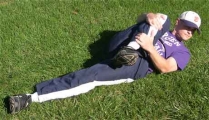
Lower back (photo 6).
|
|
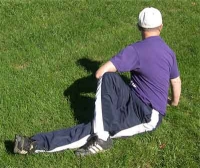
(7)
|

(8)
|
Iliotibial band (photos 7, 8).
|
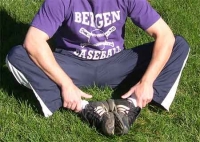
(9)
|

(10)
|
Groin (photo 9, 10).
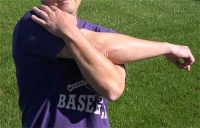
Back shoulder (photo 11).
After the team stretch, have members throw in pairs. Most people, when throwing any type of ball, have a certain “makeup” in the way their body mechanics work when performing athletic moves. Pay close attention to members’ arm angles as the ball leaves their hand. Do they throw with a free, easy motion and a certain flexibility? Are their elbows up as their arms prepare to come forward and across their body with the throw, or do their arm angles sink as they release the ball? Regardless of release point, members with strong arms will exhibit a flexible yet controlled forward motion from a raised elbow position, resulting in a ball that seems to “fly” out of the member’s hand. A raised elbow places the hand in a dominant position on the ball when throwing, allowing the member to “get on top of” the ball; this type of thrown ball with be less apt to sink as it reaches its target. Members who have this ability are best suited for the positions that demand longer throws, such as shortstop and third base.
Some members will already know what position they want to play, while others may need to be shuffled around the field to see where best they fit. However, unless you have another member who has agreed to take over the managing duties, this is your team, and you are going to be the one expected to write the lineup and make substitutions. Shortstop may be the glamour position, and there will be a high demand for those who want to play there, but if you want to win, you need to understand what is demanded from this and other positions before you can create a proper defense.
The very first thing you must look for in a player relative to where he wants to play is his current fitness level and body type. Have players run short sprints in the outfield during warm-ups; watch for running coordination and balance. For instance, does the member’s head bob up and down while running, or does his head stay still? A “quiet” head suggests a smooth gait and therefore more controlled vision when making an athletic move. These types of members may be best suited to play in the middle of the diamond (shortstop, second base, centerfield); the best athletes play these positions because they require a player to cover the most ground the most quickly. Does a member appear to be fighting himself or look awkward when attempting to run, throw, or hit? Also, does the member have a slender frame, or does he have a few extra pounds around his midsection that keep him from having that quick first step necessary to play the most active positions? Quick lateral movement is essential for playing any sport.
After stretching, running, and throwing are complete, conduct batting practice. Hitting is perhaps the easiest skill to disseminate because the results will speak for themselves. You will notice that the best hitters will have the best balance and bat speed. Does the ball meeting the bat result in a loud crack (or “ping”)? Does the member’s weight shift from his back leg to his front before contact? Does the barrel of the bat stay level through the hitting zone, or does he drop his back shoulder in an attempt to lift the ball, which results in nothing but easy fly balls? Because softballs are larger and less aerodynamic than baseballs, more backspin is required on the ball for it to travel. To achieve this, look to hit a pitch that drops below the hands and then chop down on it. The best hitters will stand out immediately.
A quick note about rules: Most softball leagues have certain team requirements, which include rules that stipulate there be at least one or even two female players on the field and in the lineup at all times. Even without this rule, do your best to recruit female members to the team. Girls’ softball is played in nearly every high school and college in the country, and there is a good chance that you already have members in your station who have the skills and experience to compete and help your team win.
Next time, we will head outdoors and visit the Bergen Community College baseball field to teach fundamental fielding and hitting techniques. Enjoy the World Series!
Derek Rosenfeld is an associate editor for Fire Engineering. He is beginning his sixth season as the assistant baseball coach at Bergen Community College in Paramus, New Jersey. He is also an infielder for the semipro North Haledon (NJ) Reds. During the mid-90s, Rosenfeld was a three-year starter at second base for the Ramapo College baseball team in Mahwah, New Jersey, where he earned all-New Jersey Athletic Conference honors and was a two-time New Jersey Collegiate Baseball Association (NJCBA) all-star selection. He was named MVP of the 1997 NJCBA All-Star Game. He has a bachelor’s degree in communications from Ramapo College.

